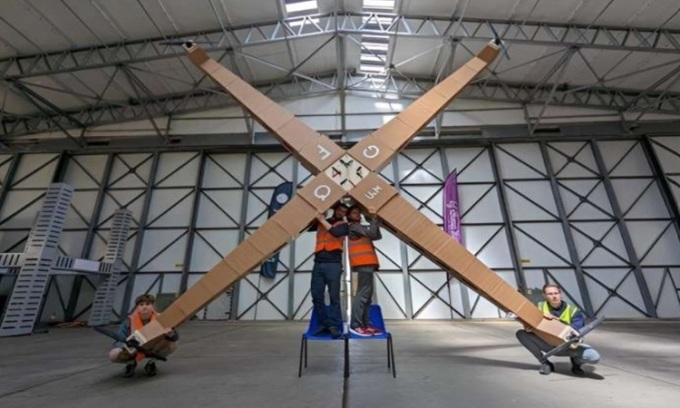The University of Manchester's quadcopter drone is 6.4 metres wide, equipped with four electric motors and autonomous flight functions.

The research team built a drone model from foam plastic. Photo: University of Manchester
Engineers at the University of Manchester have built and tested the world's largest quadcopter. The drone, made from cardboard-like foamboard, is 6.4 meters wide and weighs 24.5 kilograms, just 0.5 kilograms short of the weight limit set by the Civil Aviation Authority (CAA), Phys.org reported on October 23. The advanced drone design, called the Giant Foamboard Quadcopter (GFQ), is unlike any other drone currently available. Its four wings are made from a series of hollow box structures that can be easily disassembled for transport.
The project began as an activity to inspire students to develop their design creativity by utilizing low-cost, suitable and readily available materials for lightweight aerospace structures that are more environmentally friendly than carbon fiber. Unlike carbon fiber, low-density sheet material is easily recycled and can even be biodegradable. The team hopes that the project will encourage the next generation of designers to think about sustainability from a completely new perspective.
“Foam is an exciting material. If used properly, we can create complex aeronautical structures where each part is designed to be as strong as needed. Thanks to this design expertise and contextual research, we can confidently say this is the world’s largest quadcopter,” said Dan Koning, an engineer at the University of Manchester who led the design and construction of the vehicle.
While this drone was developed purely as a proof-of-concept exercise, future versions of the vehicle could be used to carry large cargo over short distances or for aerial docking experiments. The quadcopter is made from 5mm thick foamboard sheets with a foam core and a paper outer shell. The foamboard is laser-cut to the desired dimensions and assembled into 3D structures by hand, using only hot melt adhesive.
The GFQ is powered by four electric motors powered by a 50-volt battery. It also has a flight control system and can fly autonomously. Its first flight took place on July 5, 2023, inside the main hangar at the Snowdonia Aerospace Centre. The project builds on the previous success of a similarly large fixed-wing foam aircraft in 2022. The team is now working to optimize the GFQ's design.
An Khang (According to Phys.org )
Source link



![[Photo] General Secretary To Lam visits exhibition of achievements in private economic development](https://vphoto.vietnam.vn/thumb/1200x675/vietnam/resource/IMAGE/2025/5/18/1809dc545f214a86911fe2d2d0fde2e8)
![[Photo] More than 17,000 candidates participate in the 2025 SPT Competency Assessment Test of Hanoi National University of Education](https://vphoto.vietnam.vn/thumb/1200x675/vietnam/resource/IMAGE/2025/5/17/e538d9a1636c407cbb211b314e6303fd)
![[Photo] National conference to disseminate and implement Resolution No. 66-NQ/TW and Resolution No. 68-NQ/TW of the Politburo](https://vphoto.vietnam.vn/thumb/1200x675/vietnam/resource/IMAGE/2025/5/18/adf666b9303a4213998b395b05234b6a)






















![[Photo] Prime Minister Pham Minh Chinh chairs meeting on science and technology development](https://vphoto.vietnam.vn/thumb/1200x675/vietnam/resource/IMAGE/2025/5/17/ae80dd74c384439789b12013c738a045)

































































Comment (0)